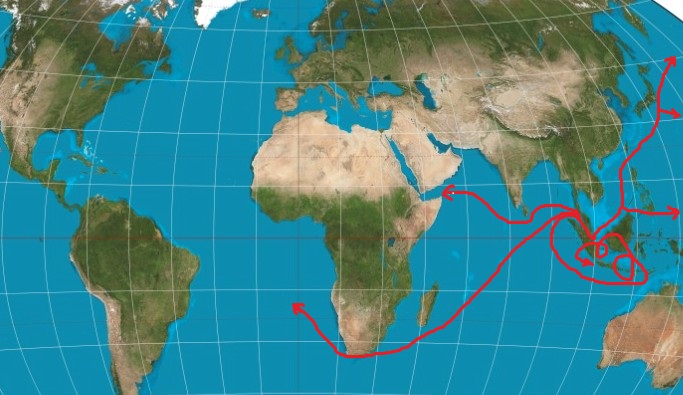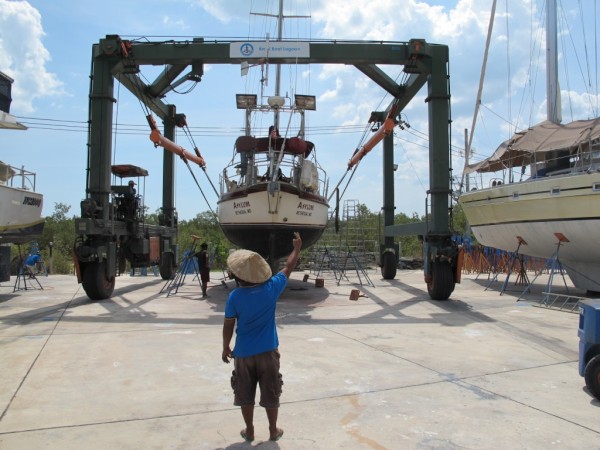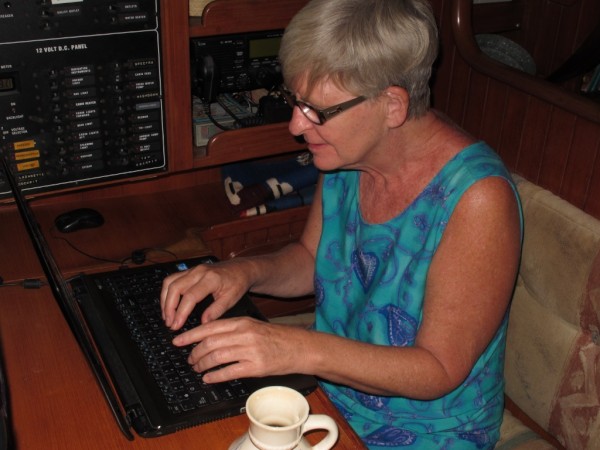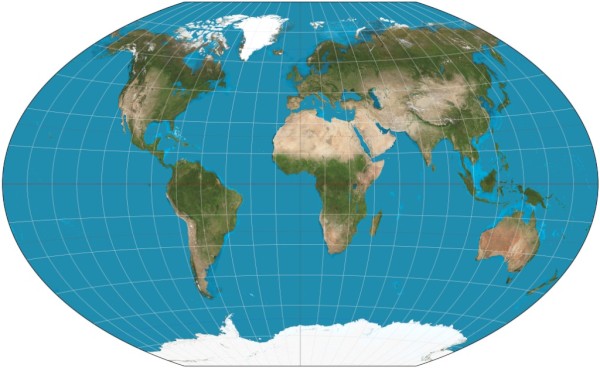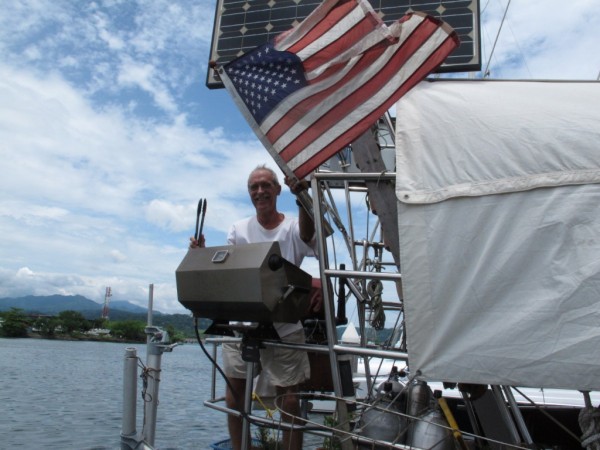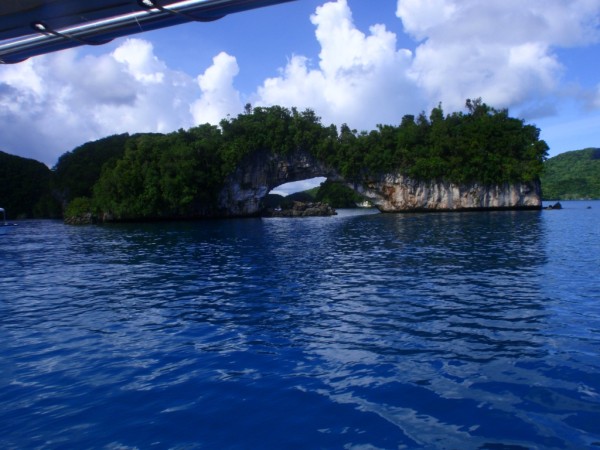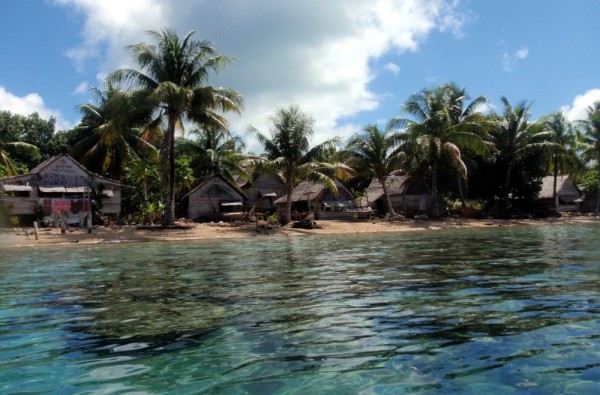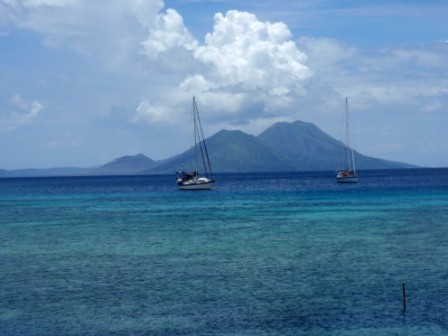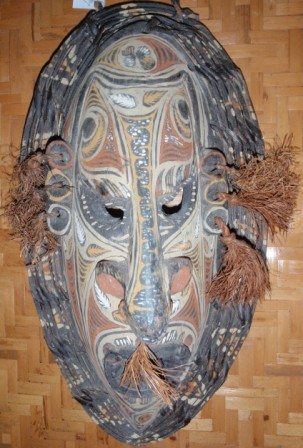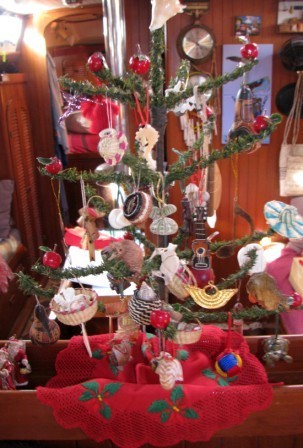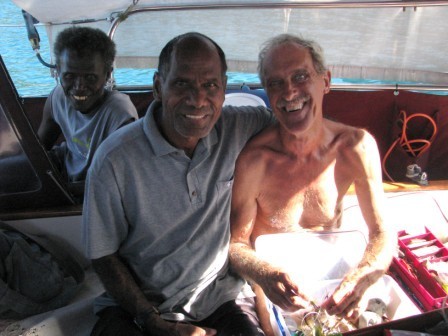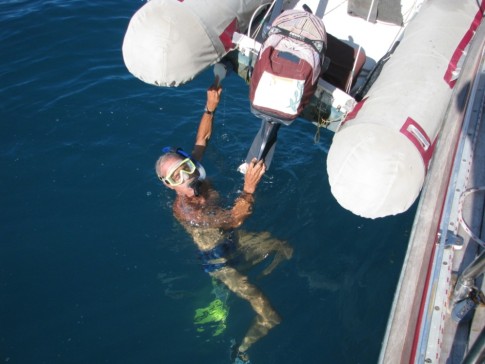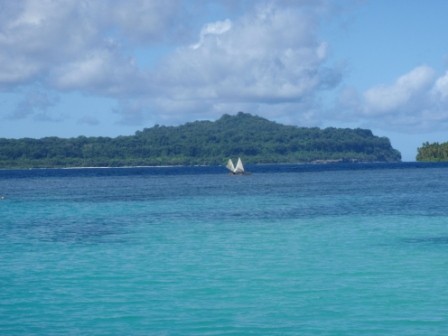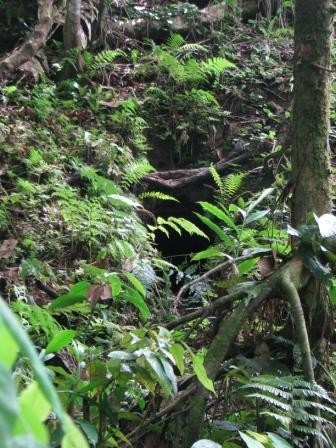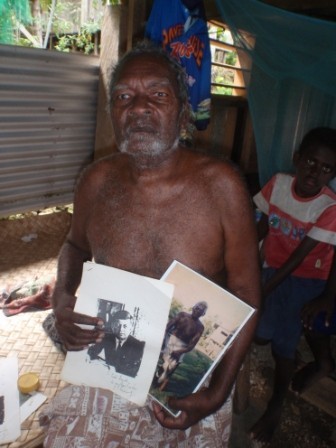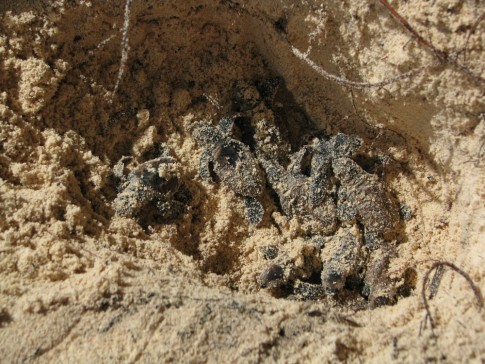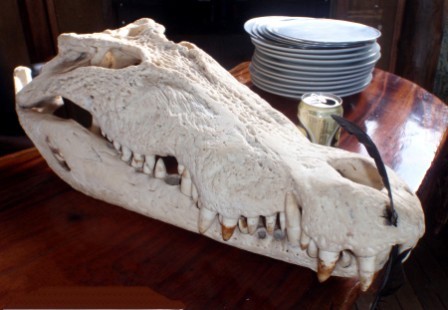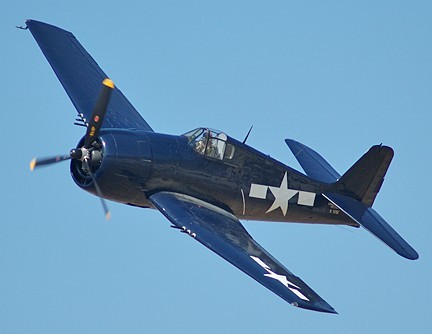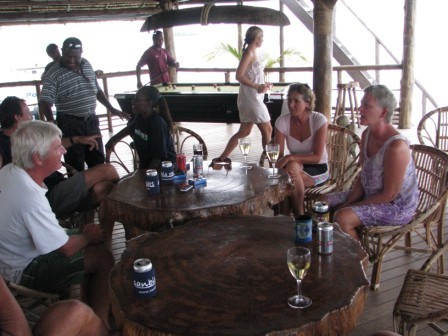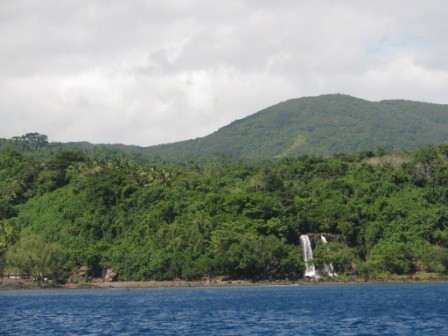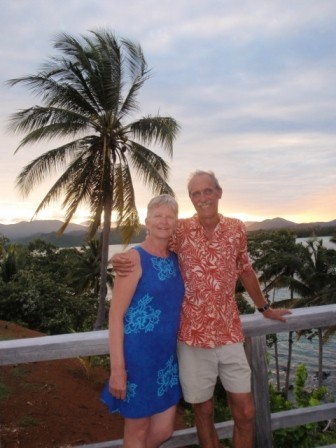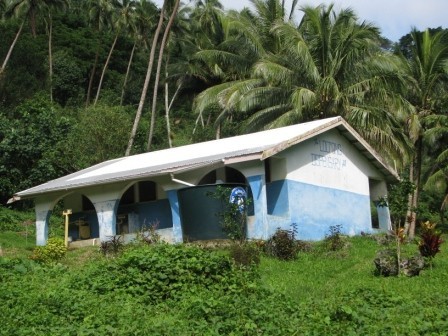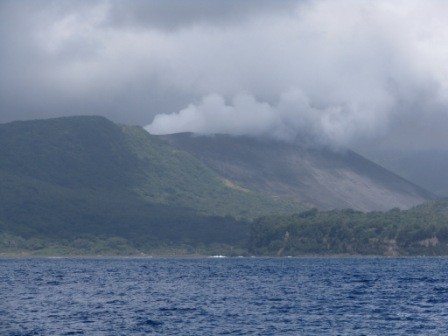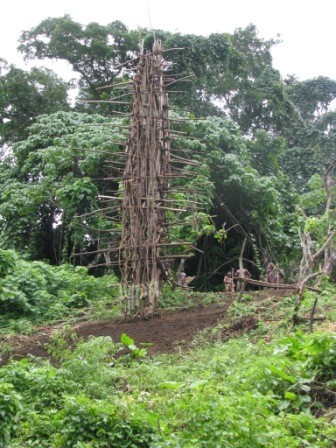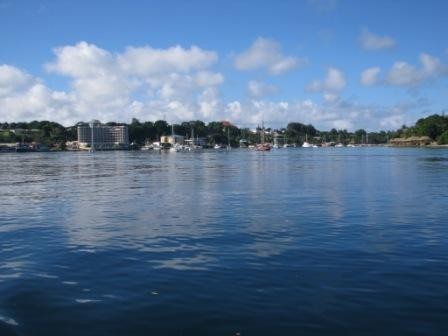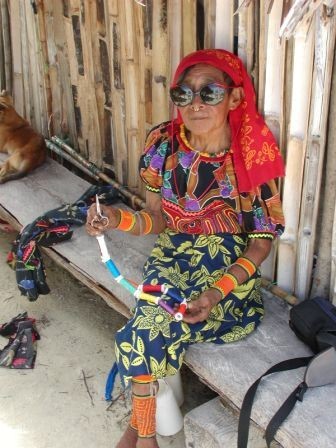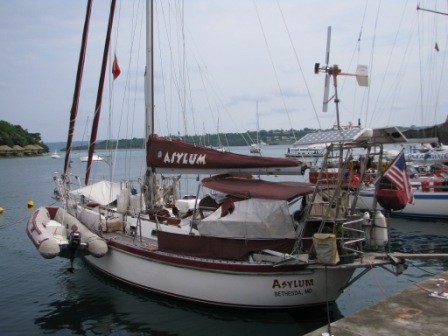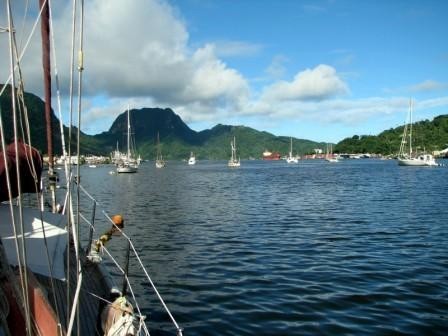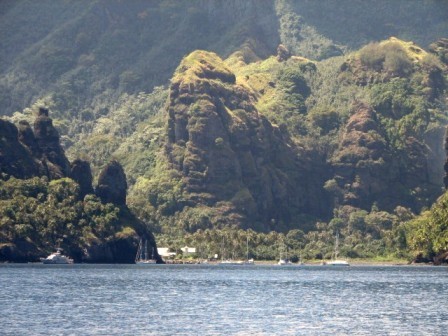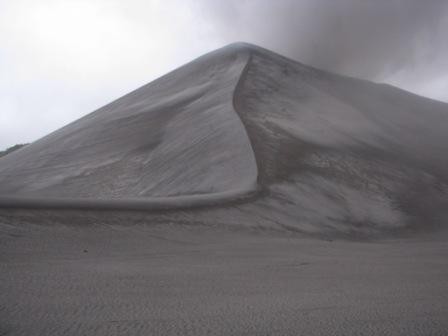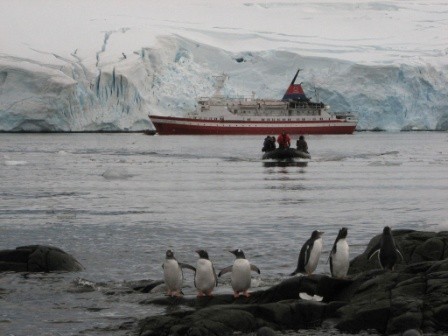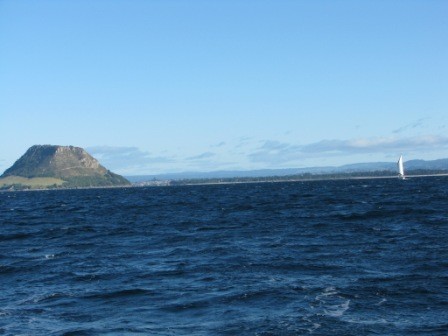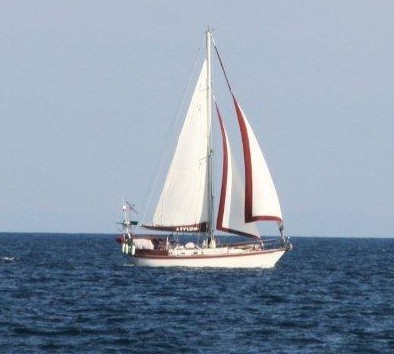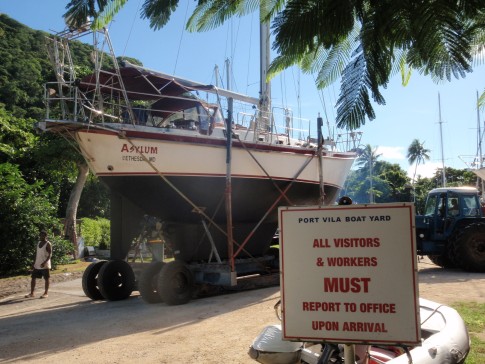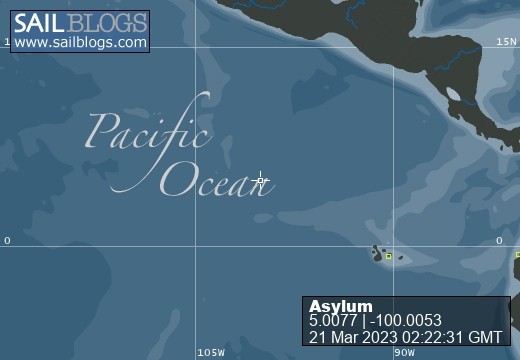
Asylum
22 June 2019 | Straits Quay Marina, Penang, Malaysia
17 July 2016 | Penang, Malaysia
20 February 2016 | Penang, Malaysia
02 October 2015 | Thailand
11 April 2015 | Krabi Boat Lagoon Marina, Thailand
25 December 2014 | Langkawi, Malaysia
04 June 2014 | Philippines
07 January 2014 | Brookeville, MD
04 July 2013 | Subic Bay Yacht Club, Philippines
31 October 2012 | Palau
02 December 2011 | Hermit Islands, Papua New Guinea
08 November 2011 | Maryland, USA
15 May 2011 | Kavieng, New Ireland, PNG
26 April 2011 | Kavieng, New Ireland
26 March 2011 | Kokopo, New Britain, Papua New Guinea
16 March 2011 | Kokopo, New Britain, Papua New Guinea
12 February 2011 | From Peava again
05 February 2011 | Solomon Islands
01 December 2010 | From Lola Island, VonaVona Lagoon, Solomon Islands
30 November 2010 | Peava, Nggatoke, Solomon Islands
Inmate Update #9: Venezuela to Bonaire
15 November 2001 | Kralendijk, Bonaire
Inmate Update #9 November, 2001
Hard to believe another 5 months has passed. We arrived in Venezuela in early June, and by the time you read this it will be mid-November and we'll be in Bonaire. I'm starting this from our last stop in Venezuela where we're anchored off a tiny island with the most luminescent sand you can imagine (at night it looks like it must have underground lighting), one lone palm tree, and a couple flocks of fish-focused birds. We're in Las Aves, a small, middle-of-nowhere archipelago about 35 miles east of Bonaire that belongs to Venezuela. Aptly named by some early explorer, the place is crawling--er, flocking--with birds. Red-footed boobies, pelicans, frigates, white things that look like seagulls but aren't (terns?), heron, cranes, egrets, and more. The baby boobies with their fuzzy white bodies and little black faces look like baby monkeys sitting in nests. They sleep with their heads hanging over the side of the nest, like they're peering over for something they dropped, and look like they're about to fall out. I tell ya, it's enough to turn an otherwise sane person into a birdwatcher! (Never mind that we've already adopted most of their goofy habits when we snorkel and dive...)
But I digress. Back in June, when we arrived in Venezuela, we stayed in Porlamar, on Isla Margarita for about a week. Long enough to make arrangements to go to Merida (on the mainland) to study Spanish and commit (in the form of a large check) to returning to Porlamar later in the summer re-rig the boat. We then poked our way over the next week through lovely island and coastal anchorages, toward Puerto la Cruz, on the mainland's north coast. There's no good place to anchor in PLC, so we had a reservation at a marina--the ritzy one that was trying to attract cruisers by dramatically dropping its prices. And it worked: cruisers were attracted. The small marina operation was part of a major (expensive) resort/hotel complex, the luxurious facilities of which were available even to us low-paying guests (we especially liked collecting big warm clean towels twice a day at the pool). We think the marina was just there to provide atmosphere to the resort, as they couldn't be making any money off us and there were always hotel guests walking along the pier, often taking pictures of each other in front of our boats. We were happy to oblige. We were also happy to have, in high-theft, security-conscious Venezuela, a guard with a serious-looking holstered sawed-off shotgun stationed on the pier at our stern. That made it a lot easier to leave the boat while we headed off to Merida for 2+ weeks.
Merida (city) is the capital of Merida (state) in the Venezuelan Andes. It's also a college town, home of the University of Los Andes, and the site of The Iowa Institute, a small language school founded by a woman from Iowa who married a Venezuelan engineer studying at the University of Iowa. It was something else walking into the classroom in an old, thick-walled hacienda building up there in the Andes mountains and seeing an Iowa Hawkeyes banner on the wall!
We'd heard a lot about Merida and the Institute from fellow cruisers, including the consistent advice to "stay with Gioia." Gioia (Joy-ah), it turned out, was a young Venezuelan woman who lived with her widowed mother and rented out (only to cruisers) 2 rooms in her house. It would be too hard to explain here how wonderful it was staying there and how hopelessly in love we fell with her family--especially her mother and 90-year-old spinster aunt, Tata, who lived in the apartment below. The mother and aunt, who was mostly deaf and spoke no English, took an immediate shine to Jim, nursing him thru the minor surgery he had on his elbow in Merida and a pesky intestinal bug that he acquired. While we were there, Jim also decided he'd had enough of pony tails, so late one afternoon we set out to find someone to chop it off (I refused, having become fond of the perfect, Shirley-temple-like ringlet that was his tail). When we returned to the house, and the two old ladies realized the pony-tail was gone, they didn't say a word but beamed and broke into happy applause. At the end of our scheduled 2 weeks, when we wanted to extend our stay in Merida but Gioia had another reservation for our room, we were the first ever to be allowed to move in downstairs with Aunt Tata for a few nights. We had to stop her from trying to empty the closet in our room for us, one that probably hadn't been opened in 50 years. When I got a touch of a cold and Jim had his stomach grippe, she plied us both with warm herb potions that she brewed in her funny old kitchen. When we left, she gave us a finely crocheted table doily that she had made years ago.
Not only was our "home stay" wonderful, we also thoroughly enjoyed our Spanish classes at the Iowa Institute. Having both tested into Level I, we opted to go with private classes for the two of us: 2 hours in the morning and 2 in the afternoon, with different teachers for the a.m. and p.m. sessions. La Profesoras spoke almost entirely in Spanish from day 1, tho sometimes we wore them down and forced them into English. Kathy, La Directora from Iowa, has organized the program of instruction to be very flexible and accommodating to the needs of the students (who include everything from business and embassy staffs to backpackers who drop in for a week of lessons), so we could tailor the sessions to what we needed/wanted. Her main business, it turned out, was teaching English to Venezuelans, and our favorite waiter at our favorite lunch spot was one of the English students and we practiced on each other during the noon hours. I will be the first to admit, however, that despite the great instruction we had and conversational opportunities offered, I will never be a good Spanish speaker, and will always live in the present tense when I do. What a language! Not even French has that many irregularities. When we do fumble around and try to speak, we take no small amount of pride in the fact that communication does seem to occur: we generally seem to get what we want. (And I don't think that we've yet called anyone a pregnant umbrella!)
Our time in Merida was hardly all work and no play (tho we did dutifully do our homework each night). We were there with friends, Dennis and Debbie, whose boat The W.C. Fields was back at the marina with Asylum. They too were taking Spanish classes, but that didn't keep us from being tourists. Merida boasts often and proudly about its Telefarico, the longest and highest cable car in the world. It rises in four stages from the base in the city (at about Denver altitude) to 16,000 feet. We had been warned to take warm clothes for this ride, and fortunately were loaned wool hats, gloves, and parkas, which we really needed up there! Dennis had taken his portable GPS and we have a picture of it sitting at the base of the frozen statue of the appropriately named Virgin of the Snow showing an altitude of 15,698 feet! Unfortunately when we reached the top we were socked in by a cloud so didn't see the much-touted view of the mountains to Columbia. But the cloud notwithstanding, it was an impressive ride--both in engineering and vistas--up over the city, the surrounding Andean valley, and mountain side.
We also toured to the north and south of Merida, thru picture-postcard Andean villages, an old coffee plantation, and a national park where we saw 2 of the 10 great Andean condors left in existence. In town, we found a concert band in the park and a Mozart Festival concert. We also learned there was to be a flamenco dance concert, which we all thought might be interesting. Dennis and Debbie scoped it out between classes, finding the building and determining in their fledgling Spanish from the security guard across the street that the concert was at 7 o'clock. We set out at 6:45 to walk the 2 ½ blocks to the hall, when the skies opened, sending great torrents of water gushing down Merida's streets. We were easily slogging thru 5 inches of water in some crossings and couldn't have been more soaked when we arrived if we'd jumped off the side of our boats into the sea! Standing and dripping in line to buy tickets, we learned that the show started at 7:30, not 7:00--seems their fledgling Spanish had failed to pick up the "y media" (or "half past") part of the time. Then 7:30 became 8:00 became 8:30, as we stood in the entry hall drip drying and waiting to be admitted to the auditorium. The people-watching was good, among those milling around lots of women and little girls in bright red dresses with their dark hair pulled back into tight, severe, flamenco buns that makes their eyes seem to slant up. But little girls?? I suggested warily to Jim, Debbie and Dennis that perhaps what we were about to attend was a dance school recital... And that's exactly what it was. For sure we were the only four people in the audience without tripods, flashes, digitals, video and movie cameras.
Some of the dance students were more skilled than others, shall we say. One who will always stick in our hearts and memories we came to call "Embassy Wife." Clearly a middle-aged gringa, she had short, strawberry-blond hair that wasn't meant to hold the requisite flamenco dancer's flower. She also didn't exactly have the, uh, requisite flamenco dancer's hour-glass figure for wearing a flamenco dancer's form-fitting dress. But bless her heart, she tried. When in one of her two numbers the troupe was leaping about, smartly thwapping their fans open and shut, we thought she was going to let fly with hers across the stage and/or twirl herself out into the audience. She was a model of concentration, though, with the tip of her tongue poking out the corner of her mouth--as her flower flopped down over her eye--in earnest pursuit of the beat. In another ensemble number, where each of the paired women stared fixedly into her partner's eyes, I'm absolutely convinced that this poor woman's partner was thinking, "Why do I have to be the one to dance with Embassy Wife??" But some of the dancers really looked the flamenco part and knew what they were doing; even a couple of the little girls were impressive, with bright flamenco futures. The guitar player alone was worth the price of admission. By the time it was over we were all dry and a great time was had by all.
We reluctantly left Merida after 2 ½ weeks and returned to Asylum in the marina in Puerto la Cruz. There, in an effort not to let what little Spanish we had learned leak out of our brains, we tried to study our books and notes, but also discovered one of the local TV channels (which we could get because we were in a marina) was fixated on the show Friends, whose dopey dialogue even we could understand in Spanish subtitles. Even I could have been a translator for the show! My personal favorite was when one of the female characters said she was going to "jump into my jammies." The subtitle had her jumping into "marmalade"! I guess some things just don't translate...
We also set to making arrangements to visit another of Venezuela's proud boasts, Angel Falls, the world's highest waterfall. We did this trip with Dennis and Debbie again and it was a highlight of our cruiser escapades. The Falls can only be reached by boat (or you fly over them), and only in the rainy season. We were planning to go early in the rainy season (first week in Aug), but our guide assured us there was already enough water to get there. We took a bus (4 ½ hours) from Puerto la Cruz to Ciudad Bolivar (the capital of Bolivar state), and then a little 6-seater plane (one of which was occupied by the pilot, a burly guy in a trucker's hat, which made me wonder if he'd stopped at the wrong terminal to pick up his load...) to the tiny Indian village of Canaima, where trips to the Falls are staged. There we met up with our guide, Manuel, and transferred ourselves and much gear to a big dugout canoe--literally a thick, rough canoe dug out of an enormous tree. And off we went, up the river, up the rapids, to our "camp" on a little island near the bottom of Angel Falls. It was an amazing ride: at one point we had to get out and walk overland across a small peninsula because the canoes weren't allowed to take passengers over a certain stretch of rapids, in some places there was barely enough water for the prop on the big ol' Yamaha 48 to clear the rocks, and in another, the canoe was literally bouncing off truck-sized boulders in the middle of the river. If it hadn't been for our very skilled (and very young) Indian driver we would have been on the rocks (or in the water) many times. But what a ride and what scenery! Late in the afternoon, Manuel slowed the boat and suggested we might want to put our rain jackets on... He was right. It poured the rest of the way to the camp. Debbie couldn't find her jacket and put a garbage bag over her head. But we didn't care. We continued bouncing up the rapids and off the rocks, with endless vistas of flat-topped tepuys (what we call mesas), all with their own smaller versions of the Angel Falls cascading down the sides.
We arrived at the camp at dusk, still in the rain, and helped lug all the gear to the shelter. Which was basically a tin roof over supporting posts with some extra beams for hanging hammocks. There was a wood bench along one side and a one-sided picnic table along the other. The floor was sand. The roof leaked. There were mice in the rafters (which nibbled thru Debbie's back pack, our duffel, and one of Jim's T-shirts in search of the food morsels we stupidly left in them). The facilities were, um, our bush of choice. And we loved it! Manuel cooked amazing meals over a one-burner kerosene stove and we slept in hammocks with elegant mosquito nets. It rained so hard both nights that the river had risen dramatically by morning and we could hear it roaring just feet from the camp. We learned how to arrange ourselves crosswise in the hammocks--both to avoid the leaks and because, well, that's how you sleep in a hammock. Otherwise you look like a banana.
In the morning we woke to a brilliant blue sky, and as Manuel promised, a dramatic view of Angel Falls, virtually without leaving our hammocks. What they lack in breadth they definitely make up for in height! That morning we hiked thru the jungle to a look-out spot just across a small valley from the Falls. And every way you turned up there, the panorama offered more little falls from the surrounding tepuys--ike distant, receding echoes of the imposing Angel Falls.
A canoe, plane, bus, and cab-ride later, we were back in Puerto la Cruz where we did all the boat chores that require water and power before heading back to Margarita. Which basically translates into cleaning and fixing stuff. When Jim got to "check strainer" on his list of Jimjobs, which required that he close the thru-hull to get it out, the handle broke off in his hand. (Remember that this happened to us earlier in the year on another thru-hull!) Our choices were have the boat hauled to fix it (mucho dinero) or run a temporary hose almost the length of the boat to be able to flush the head. Needless to say, we opted for the latter, which has worked just fine and will be fixed when we have the boat hauled in Curacao in December. That we can't run the watermaker and flush the head at the same time has required only minor schedule adjustments!
Back in Margarita in mid-August we reconnoitered with friends we hadn't seen since March and started the job of re-rigging the boat. Basically that meant replacing all the old shrouds and stays--"the heavy wire things that hold the mast up--with new ones. We had ordered all the stuff to do it when we stopped in Margarita in late June, so everything was ready to go and it turned out not to be the daunting task we had expected. We also replaced the lifelines and all the deck hardware, all of which was original and much of which was so seized up the rigger couldn't believe that we could even trim the sheets!
So Asylum had shiny new rigging and we were ready to set the sails and start heading west, sailing downwind for a change. Except that now the motor on the windlass (the thing that raises and lowers the chain and anchor) died. So we weren't going anywhere until that got fixed. Tried a local machine shop and thought we had it, but the next time we tried to use it, it whimpered and died again. Had to order a new one from the States, and that meant WFP (waiting for parts).
And then September 11 happened. Like everyone else in the world, we all sat stunned and glued to CNN at the local cruiser hangout--the only place with English TV. A bunch of us had gathered to take the bus into town that morning. Jim went to drop something off at the restaurant and returned to the group having just heard the report of the first plane flying into the WTC. We all headed to the TV, just in time to hear the report of the second plane. And then came "a fire at the Pentagon," then the White House being evacuated, and then, and then, and then.... We had a friend who had left just minutes before to fly to Caracas on her way to Boston where she was going to remove the life support system on her dying mother. She spent 2 days in Caracas before returning to Margarita and never did get to Boston before her mother died. Other cruiser friends were in New York, scheduled to return to Venezuela that day. They couldn't get out till the 25th. Over the next few days we learned that we had two cousins directly affected--one at a meeting at the WTC that day and another who lives in the neighborhood--and a former colleague killed at the Pentagon. We watched the news in English when we were at the restaurant, in Spanish (over the local stations) when we were on the boat, and when we could get it, we listened to NPR over the single sideband radio. Even with our sketchy coverage we were in overload. None of us could imagine what it must have been like up there with the constant barrage of words and images we knew you were getting. We all talked about how many of our friends and families had thought we were nuts to be doing what we were doing--how dangerous it was--but all of us were very grateful to be where we were.
It was almost a month later, on 10/10, that everything was fixed (??), the provisioning done, and we were ready to head west. Next official stop, Bonaire, but in between, 5 glorious weeks poking our way thru the out-islands of Venezuela. The first 2 at the island of Tortuga where we were anchored off a tiny little cay that had nothing there but a small, ramshackle fishing camp on the beach. The sand on this beach was so dazzlingly white it almost hurt your eyes, and at night, so brilliantly white it glowed like someone was shining light on snow. From there we did an 85-mile overnighter to Los Roques, an archipelago of reefs and small islands with equally dazzling beaches. We putzed our way thru those little islands for 10 days, fishing (with considerable success!), snorkeling, reading, and occasionally thinking about (but not doing) boat chores. Only one night did we share an anchorage with another boat, and if someone came along, we moved. After Los Roques, it was another 10 days in the next little archipelago, Las Aves, which were even more remote and captivating. I'd still be there...
For 5 weeks we ate nothing but fish, wore no shoes, generated no laundry, and talked to almost nobody but each other. In the Aves we were approached by a boat full of local fisherman, who wanted to trade fish for rum and a pack of cigarettes. The first day they came, we thought they meant a fish, but they wanted us to take the whole basketful, which had 2 big crabs, 2 snappers, and 3 sea bass. I absolutely hate using cigarettes as currency, but we'd been told that's what they usually want, and who am I to fight culture... They came back almost daily with more fish, including lobster--more fish than we could keep up with. And we were catching our own as well! In two of the anchorages, we had very large (3-4 ft) barracuda take up residence under the boat. These guys were no dummies, hanging out down there patiently waiting for and feasting on the scraps Jim tossed over when he cleaned fish off the stern. Whenever they heard noise from above, even when we just dumped water over the side, they surfaced to check out what was coming. We called them Balthazar and Bartholomew. It was a little disconcerting skinny-dipping off the side tho...
But after 5 weeks the lettuce and most of the other fresh stuff was gone and we'd already postponed our reservation for a mooring in Bonaire, so we reluctantly hauled up the anchor and pointed Asylum west again. On the way there, we damn near hit a whale. I was driving and saw what I thought was a spout of water. Next thing I knew, we could see the fin above the water (we've been told it was a pilot whale) and his dark shape shimmering just below the surface, not far off the bow! I quickly changed course--he was that close--while Jim turned the engine on to make sure he heard us. And off he went, with one more blow (perhaps thanking us for not running into him?), in the direction of the Aves, where we'd just come from.
With that, we're in Bonaire ("divers' paradise"), and I'll stop for now. I'd planned to have this out a few days ago, for your leisurely Thanksgiving weekend reading, but was unable to connect to AOL. So instead of wishing that everyone has a wonderful Thanksgiving, we hope you had one! We'll be here till early December, then head to Curacao where the boat will be hauled, cleaned, painted, and otherwise spruced up while we go home for the holidays. Can't believe it's so soon!
Chao for now!
The Inmates
Hard to believe another 5 months has passed. We arrived in Venezuela in early June, and by the time you read this it will be mid-November and we'll be in Bonaire. I'm starting this from our last stop in Venezuela where we're anchored off a tiny island with the most luminescent sand you can imagine (at night it looks like it must have underground lighting), one lone palm tree, and a couple flocks of fish-focused birds. We're in Las Aves, a small, middle-of-nowhere archipelago about 35 miles east of Bonaire that belongs to Venezuela. Aptly named by some early explorer, the place is crawling--er, flocking--with birds. Red-footed boobies, pelicans, frigates, white things that look like seagulls but aren't (terns?), heron, cranes, egrets, and more. The baby boobies with their fuzzy white bodies and little black faces look like baby monkeys sitting in nests. They sleep with their heads hanging over the side of the nest, like they're peering over for something they dropped, and look like they're about to fall out. I tell ya, it's enough to turn an otherwise sane person into a birdwatcher! (Never mind that we've already adopted most of their goofy habits when we snorkel and dive...)
But I digress. Back in June, when we arrived in Venezuela, we stayed in Porlamar, on Isla Margarita for about a week. Long enough to make arrangements to go to Merida (on the mainland) to study Spanish and commit (in the form of a large check) to returning to Porlamar later in the summer re-rig the boat. We then poked our way over the next week through lovely island and coastal anchorages, toward Puerto la Cruz, on the mainland's north coast. There's no good place to anchor in PLC, so we had a reservation at a marina--the ritzy one that was trying to attract cruisers by dramatically dropping its prices. And it worked: cruisers were attracted. The small marina operation was part of a major (expensive) resort/hotel complex, the luxurious facilities of which were available even to us low-paying guests (we especially liked collecting big warm clean towels twice a day at the pool). We think the marina was just there to provide atmosphere to the resort, as they couldn't be making any money off us and there were always hotel guests walking along the pier, often taking pictures of each other in front of our boats. We were happy to oblige. We were also happy to have, in high-theft, security-conscious Venezuela, a guard with a serious-looking holstered sawed-off shotgun stationed on the pier at our stern. That made it a lot easier to leave the boat while we headed off to Merida for 2+ weeks.
Merida (city) is the capital of Merida (state) in the Venezuelan Andes. It's also a college town, home of the University of Los Andes, and the site of The Iowa Institute, a small language school founded by a woman from Iowa who married a Venezuelan engineer studying at the University of Iowa. It was something else walking into the classroom in an old, thick-walled hacienda building up there in the Andes mountains and seeing an Iowa Hawkeyes banner on the wall!
We'd heard a lot about Merida and the Institute from fellow cruisers, including the consistent advice to "stay with Gioia." Gioia (Joy-ah), it turned out, was a young Venezuelan woman who lived with her widowed mother and rented out (only to cruisers) 2 rooms in her house. It would be too hard to explain here how wonderful it was staying there and how hopelessly in love we fell with her family--especially her mother and 90-year-old spinster aunt, Tata, who lived in the apartment below. The mother and aunt, who was mostly deaf and spoke no English, took an immediate shine to Jim, nursing him thru the minor surgery he had on his elbow in Merida and a pesky intestinal bug that he acquired. While we were there, Jim also decided he'd had enough of pony tails, so late one afternoon we set out to find someone to chop it off (I refused, having become fond of the perfect, Shirley-temple-like ringlet that was his tail). When we returned to the house, and the two old ladies realized the pony-tail was gone, they didn't say a word but beamed and broke into happy applause. At the end of our scheduled 2 weeks, when we wanted to extend our stay in Merida but Gioia had another reservation for our room, we were the first ever to be allowed to move in downstairs with Aunt Tata for a few nights. We had to stop her from trying to empty the closet in our room for us, one that probably hadn't been opened in 50 years. When I got a touch of a cold and Jim had his stomach grippe, she plied us both with warm herb potions that she brewed in her funny old kitchen. When we left, she gave us a finely crocheted table doily that she had made years ago.
Not only was our "home stay" wonderful, we also thoroughly enjoyed our Spanish classes at the Iowa Institute. Having both tested into Level I, we opted to go with private classes for the two of us: 2 hours in the morning and 2 in the afternoon, with different teachers for the a.m. and p.m. sessions. La Profesoras spoke almost entirely in Spanish from day 1, tho sometimes we wore them down and forced them into English. Kathy, La Directora from Iowa, has organized the program of instruction to be very flexible and accommodating to the needs of the students (who include everything from business and embassy staffs to backpackers who drop in for a week of lessons), so we could tailor the sessions to what we needed/wanted. Her main business, it turned out, was teaching English to Venezuelans, and our favorite waiter at our favorite lunch spot was one of the English students and we practiced on each other during the noon hours. I will be the first to admit, however, that despite the great instruction we had and conversational opportunities offered, I will never be a good Spanish speaker, and will always live in the present tense when I do. What a language! Not even French has that many irregularities. When we do fumble around and try to speak, we take no small amount of pride in the fact that communication does seem to occur: we generally seem to get what we want. (And I don't think that we've yet called anyone a pregnant umbrella!)
Our time in Merida was hardly all work and no play (tho we did dutifully do our homework each night). We were there with friends, Dennis and Debbie, whose boat The W.C. Fields was back at the marina with Asylum. They too were taking Spanish classes, but that didn't keep us from being tourists. Merida boasts often and proudly about its Telefarico, the longest and highest cable car in the world. It rises in four stages from the base in the city (at about Denver altitude) to 16,000 feet. We had been warned to take warm clothes for this ride, and fortunately were loaned wool hats, gloves, and parkas, which we really needed up there! Dennis had taken his portable GPS and we have a picture of it sitting at the base of the frozen statue of the appropriately named Virgin of the Snow showing an altitude of 15,698 feet! Unfortunately when we reached the top we were socked in by a cloud so didn't see the much-touted view of the mountains to Columbia. But the cloud notwithstanding, it was an impressive ride--both in engineering and vistas--up over the city, the surrounding Andean valley, and mountain side.
We also toured to the north and south of Merida, thru picture-postcard Andean villages, an old coffee plantation, and a national park where we saw 2 of the 10 great Andean condors left in existence. In town, we found a concert band in the park and a Mozart Festival concert. We also learned there was to be a flamenco dance concert, which we all thought might be interesting. Dennis and Debbie scoped it out between classes, finding the building and determining in their fledgling Spanish from the security guard across the street that the concert was at 7 o'clock. We set out at 6:45 to walk the 2 ½ blocks to the hall, when the skies opened, sending great torrents of water gushing down Merida's streets. We were easily slogging thru 5 inches of water in some crossings and couldn't have been more soaked when we arrived if we'd jumped off the side of our boats into the sea! Standing and dripping in line to buy tickets, we learned that the show started at 7:30, not 7:00--seems their fledgling Spanish had failed to pick up the "y media" (or "half past") part of the time. Then 7:30 became 8:00 became 8:30, as we stood in the entry hall drip drying and waiting to be admitted to the auditorium. The people-watching was good, among those milling around lots of women and little girls in bright red dresses with their dark hair pulled back into tight, severe, flamenco buns that makes their eyes seem to slant up. But little girls?? I suggested warily to Jim, Debbie and Dennis that perhaps what we were about to attend was a dance school recital... And that's exactly what it was. For sure we were the only four people in the audience without tripods, flashes, digitals, video and movie cameras.
Some of the dance students were more skilled than others, shall we say. One who will always stick in our hearts and memories we came to call "Embassy Wife." Clearly a middle-aged gringa, she had short, strawberry-blond hair that wasn't meant to hold the requisite flamenco dancer's flower. She also didn't exactly have the, uh, requisite flamenco dancer's hour-glass figure for wearing a flamenco dancer's form-fitting dress. But bless her heart, she tried. When in one of her two numbers the troupe was leaping about, smartly thwapping their fans open and shut, we thought she was going to let fly with hers across the stage and/or twirl herself out into the audience. She was a model of concentration, though, with the tip of her tongue poking out the corner of her mouth--as her flower flopped down over her eye--in earnest pursuit of the beat. In another ensemble number, where each of the paired women stared fixedly into her partner's eyes, I'm absolutely convinced that this poor woman's partner was thinking, "Why do I have to be the one to dance with Embassy Wife??" But some of the dancers really looked the flamenco part and knew what they were doing; even a couple of the little girls were impressive, with bright flamenco futures. The guitar player alone was worth the price of admission. By the time it was over we were all dry and a great time was had by all.
We reluctantly left Merida after 2 ½ weeks and returned to Asylum in the marina in Puerto la Cruz. There, in an effort not to let what little Spanish we had learned leak out of our brains, we tried to study our books and notes, but also discovered one of the local TV channels (which we could get because we were in a marina) was fixated on the show Friends, whose dopey dialogue even we could understand in Spanish subtitles. Even I could have been a translator for the show! My personal favorite was when one of the female characters said she was going to "jump into my jammies." The subtitle had her jumping into "marmalade"! I guess some things just don't translate...
We also set to making arrangements to visit another of Venezuela's proud boasts, Angel Falls, the world's highest waterfall. We did this trip with Dennis and Debbie again and it was a highlight of our cruiser escapades. The Falls can only be reached by boat (or you fly over them), and only in the rainy season. We were planning to go early in the rainy season (first week in Aug), but our guide assured us there was already enough water to get there. We took a bus (4 ½ hours) from Puerto la Cruz to Ciudad Bolivar (the capital of Bolivar state), and then a little 6-seater plane (one of which was occupied by the pilot, a burly guy in a trucker's hat, which made me wonder if he'd stopped at the wrong terminal to pick up his load...) to the tiny Indian village of Canaima, where trips to the Falls are staged. There we met up with our guide, Manuel, and transferred ourselves and much gear to a big dugout canoe--literally a thick, rough canoe dug out of an enormous tree. And off we went, up the river, up the rapids, to our "camp" on a little island near the bottom of Angel Falls. It was an amazing ride: at one point we had to get out and walk overland across a small peninsula because the canoes weren't allowed to take passengers over a certain stretch of rapids, in some places there was barely enough water for the prop on the big ol' Yamaha 48 to clear the rocks, and in another, the canoe was literally bouncing off truck-sized boulders in the middle of the river. If it hadn't been for our very skilled (and very young) Indian driver we would have been on the rocks (or in the water) many times. But what a ride and what scenery! Late in the afternoon, Manuel slowed the boat and suggested we might want to put our rain jackets on... He was right. It poured the rest of the way to the camp. Debbie couldn't find her jacket and put a garbage bag over her head. But we didn't care. We continued bouncing up the rapids and off the rocks, with endless vistas of flat-topped tepuys (what we call mesas), all with their own smaller versions of the Angel Falls cascading down the sides.
We arrived at the camp at dusk, still in the rain, and helped lug all the gear to the shelter. Which was basically a tin roof over supporting posts with some extra beams for hanging hammocks. There was a wood bench along one side and a one-sided picnic table along the other. The floor was sand. The roof leaked. There were mice in the rafters (which nibbled thru Debbie's back pack, our duffel, and one of Jim's T-shirts in search of the food morsels we stupidly left in them). The facilities were, um, our bush of choice. And we loved it! Manuel cooked amazing meals over a one-burner kerosene stove and we slept in hammocks with elegant mosquito nets. It rained so hard both nights that the river had risen dramatically by morning and we could hear it roaring just feet from the camp. We learned how to arrange ourselves crosswise in the hammocks--both to avoid the leaks and because, well, that's how you sleep in a hammock. Otherwise you look like a banana.
In the morning we woke to a brilliant blue sky, and as Manuel promised, a dramatic view of Angel Falls, virtually without leaving our hammocks. What they lack in breadth they definitely make up for in height! That morning we hiked thru the jungle to a look-out spot just across a small valley from the Falls. And every way you turned up there, the panorama offered more little falls from the surrounding tepuys--ike distant, receding echoes of the imposing Angel Falls.
A canoe, plane, bus, and cab-ride later, we were back in Puerto la Cruz where we did all the boat chores that require water and power before heading back to Margarita. Which basically translates into cleaning and fixing stuff. When Jim got to "check strainer" on his list of Jimjobs, which required that he close the thru-hull to get it out, the handle broke off in his hand. (Remember that this happened to us earlier in the year on another thru-hull!) Our choices were have the boat hauled to fix it (mucho dinero) or run a temporary hose almost the length of the boat to be able to flush the head. Needless to say, we opted for the latter, which has worked just fine and will be fixed when we have the boat hauled in Curacao in December. That we can't run the watermaker and flush the head at the same time has required only minor schedule adjustments!
Back in Margarita in mid-August we reconnoitered with friends we hadn't seen since March and started the job of re-rigging the boat. Basically that meant replacing all the old shrouds and stays--"the heavy wire things that hold the mast up--with new ones. We had ordered all the stuff to do it when we stopped in Margarita in late June, so everything was ready to go and it turned out not to be the daunting task we had expected. We also replaced the lifelines and all the deck hardware, all of which was original and much of which was so seized up the rigger couldn't believe that we could even trim the sheets!
So Asylum had shiny new rigging and we were ready to set the sails and start heading west, sailing downwind for a change. Except that now the motor on the windlass (the thing that raises and lowers the chain and anchor) died. So we weren't going anywhere until that got fixed. Tried a local machine shop and thought we had it, but the next time we tried to use it, it whimpered and died again. Had to order a new one from the States, and that meant WFP (waiting for parts).
And then September 11 happened. Like everyone else in the world, we all sat stunned and glued to CNN at the local cruiser hangout--the only place with English TV. A bunch of us had gathered to take the bus into town that morning. Jim went to drop something off at the restaurant and returned to the group having just heard the report of the first plane flying into the WTC. We all headed to the TV, just in time to hear the report of the second plane. And then came "a fire at the Pentagon," then the White House being evacuated, and then, and then, and then.... We had a friend who had left just minutes before to fly to Caracas on her way to Boston where she was going to remove the life support system on her dying mother. She spent 2 days in Caracas before returning to Margarita and never did get to Boston before her mother died. Other cruiser friends were in New York, scheduled to return to Venezuela that day. They couldn't get out till the 25th. Over the next few days we learned that we had two cousins directly affected--one at a meeting at the WTC that day and another who lives in the neighborhood--and a former colleague killed at the Pentagon. We watched the news in English when we were at the restaurant, in Spanish (over the local stations) when we were on the boat, and when we could get it, we listened to NPR over the single sideband radio. Even with our sketchy coverage we were in overload. None of us could imagine what it must have been like up there with the constant barrage of words and images we knew you were getting. We all talked about how many of our friends and families had thought we were nuts to be doing what we were doing--how dangerous it was--but all of us were very grateful to be where we were.
It was almost a month later, on 10/10, that everything was fixed (??), the provisioning done, and we were ready to head west. Next official stop, Bonaire, but in between, 5 glorious weeks poking our way thru the out-islands of Venezuela. The first 2 at the island of Tortuga where we were anchored off a tiny little cay that had nothing there but a small, ramshackle fishing camp on the beach. The sand on this beach was so dazzlingly white it almost hurt your eyes, and at night, so brilliantly white it glowed like someone was shining light on snow. From there we did an 85-mile overnighter to Los Roques, an archipelago of reefs and small islands with equally dazzling beaches. We putzed our way thru those little islands for 10 days, fishing (with considerable success!), snorkeling, reading, and occasionally thinking about (but not doing) boat chores. Only one night did we share an anchorage with another boat, and if someone came along, we moved. After Los Roques, it was another 10 days in the next little archipelago, Las Aves, which were even more remote and captivating. I'd still be there...
For 5 weeks we ate nothing but fish, wore no shoes, generated no laundry, and talked to almost nobody but each other. In the Aves we were approached by a boat full of local fisherman, who wanted to trade fish for rum and a pack of cigarettes. The first day they came, we thought they meant a fish, but they wanted us to take the whole basketful, which had 2 big crabs, 2 snappers, and 3 sea bass. I absolutely hate using cigarettes as currency, but we'd been told that's what they usually want, and who am I to fight culture... They came back almost daily with more fish, including lobster--more fish than we could keep up with. And we were catching our own as well! In two of the anchorages, we had very large (3-4 ft) barracuda take up residence under the boat. These guys were no dummies, hanging out down there patiently waiting for and feasting on the scraps Jim tossed over when he cleaned fish off the stern. Whenever they heard noise from above, even when we just dumped water over the side, they surfaced to check out what was coming. We called them Balthazar and Bartholomew. It was a little disconcerting skinny-dipping off the side tho...
But after 5 weeks the lettuce and most of the other fresh stuff was gone and we'd already postponed our reservation for a mooring in Bonaire, so we reluctantly hauled up the anchor and pointed Asylum west again. On the way there, we damn near hit a whale. I was driving and saw what I thought was a spout of water. Next thing I knew, we could see the fin above the water (we've been told it was a pilot whale) and his dark shape shimmering just below the surface, not far off the bow! I quickly changed course--he was that close--while Jim turned the engine on to make sure he heard us. And off he went, with one more blow (perhaps thanking us for not running into him?), in the direction of the Aves, where we'd just come from.
With that, we're in Bonaire ("divers' paradise"), and I'll stop for now. I'd planned to have this out a few days ago, for your leisurely Thanksgiving weekend reading, but was unable to connect to AOL. So instead of wishing that everyone has a wonderful Thanksgiving, we hope you had one! We'll be here till early December, then head to Curacao where the boat will be hauled, cleaned, painted, and otherwise spruced up while we go home for the holidays. Can't believe it's so soon!
Chao for now!
The Inmates
Comments
| Vessel Name: | Asylum |
| Vessel Make/Model: | Tayana V-42 Cutter |
| Hailing Port: | Bethesda, MD USA |
| Crew: | Jim & Katie Coolbaugh |
| About: | |
| Extra: | Within Malaysia: 0174209362 (Maxis) WhatsApp +60174209362 |
The Meanderings of Asylum and the Inmates
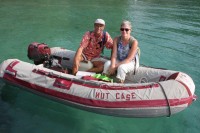
Who: Jim & Katie Coolbaugh
Port: Bethesda, MD USA
Where in the world is Asylum?
Good links
- Vesper Marine Watchmate AIS
- WinchRite Cordless Winch Handle
- Diving at Tubbataha Reef
- Royal Belau Yacht Club, Palau
- ShipTrack: Our route so far
- Passage Weather
- Interview With a Cruiser Project
- Great diving in the Solomons
- Seven Seas Cruising Association
- Divers Alert Network
- Spectra Watermakers
- Rocna Anchors
.jpeg)
